The untouched beauty of Mongolia is not just in its endless steppes or crisp blue skies but it lives in the remains of empires, monasteries, and spiritual sanctuaries. Explore historical places in Mongolia and find more than stone and silence. Each site, from the ruins of Karakorum to remote monastic retreats, carries the memory of a nation shaped by faith, resilience, and movement. These locations offer a doorway into Mongolia’s soul, where Buddhist chants once echoed and royal footsteps once left their mark. You do not simply visit them, you listen, learn, and witness a timeline told in earth and timber.
Top 10 Historical Places In Mongolia
Mongolia’s past lives on in its silent ruins, sacred monasteries, and open valleys. Each of these historical places in Mongolia tells a story rooted in tradition, belief, and royal legacy.
1. Erdene Zuu Monastery
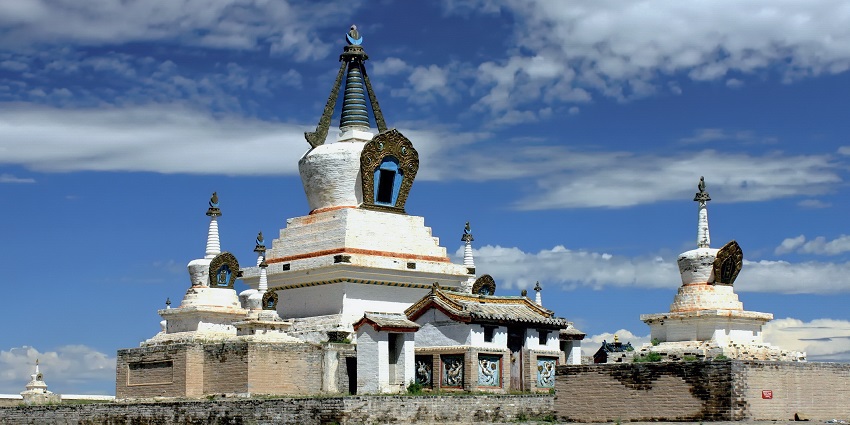
Photo: Marcin Konsek / Wikimedia Commons
Erdene Zuu Monastery sits quietly on the plains of Kharkhorin, where stone paths and white stupas echo a chapter of Mongolia that changed everything. Built in 1586, it became the first Buddhist monastery in the country and still reflects centuries of devotion. What makes it stand out among the many historical places in Mongolia is its connection to the fallen capital of Karakorum. Stones from the ruined imperial city were used to build the monastery’s walls, which are lined with 108 stupas forming a protective circle. Though much of the complex was destroyed in the 1930s, what remains is peaceful and alive. Inside, prayer halls still hold murals, wooden carvings, and sacred relics.
How To Reach: About 370 km from Ulaanbaatar. Accessible via long-distance bus or car
Timings: 9 AM – 6 PM
Nearby Attractions: Kharkhorin Museum, Orkhon River Valley, Tövkhön Monastery.
2. Karakorum Ruins
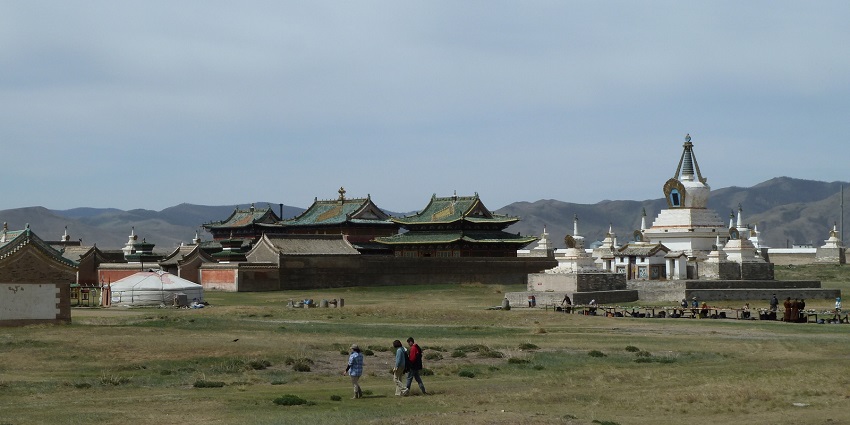
Photo: Gyula Péter / Wikimedia Commons
The windswept ruins of Karakorum lie quietly along the Orkhon River, with stone outlines and scattered relics marking the site of Mongolia’s ancient capital. Founded in the 13th century by Ögedei Khan, son of Genghis Khan, it served as the political and cultural heart of the Mongol Empire. Its former grandeur is difficult to imagine at first glance, but the remnants, old foundations, carved stone turtles, and inscriptions carry the weight of a vast history. This is one of those historical places in Mongolia where imagination fills the gaps left by time. The nearby museum helps piece it all together with displays of tools, ceramics, and items recovered from archaeological digs. What draws many here is the knowledge that Karakorum once welcomed foreign diplomats and travellers from as far as Persia and Europe.
How To Reach: Situated next to Erdene Zuu in Kharkhorin
Timings: 10 AM – 5 PM
Nearby Attractions: Orkhon Valley Cultural Landscape, Erdene Zuu Monastery
3. Gandan Tegchinlen Monastery
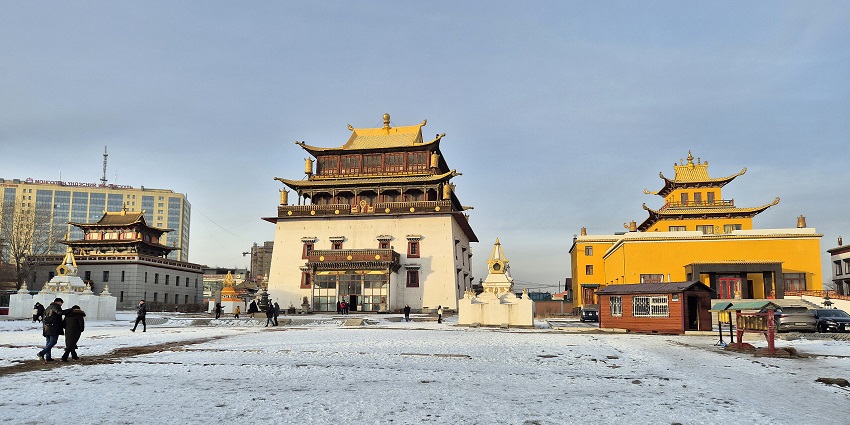
Photo: Chongkian / Wikimedia Commons
Gandan Tegchinlen Monastery stands in the centre of Ulaanbaatar, active and alive with daily religious practice. It was founded in the 1800s and continues to function today, making it one of the few monasteries that withstood the repression of the Soviet era. You can witness morning prayers as monks chant and carry out rituals. Inside the main temple is a massive statue of Avalokiteshvara, measuring 26 metres in height. The statue is built from copper, gilded in gold, and inlaid with thousands of gemstones. The complex also includes classrooms and scripture halls used for religious education. Unlike many historical places in Mongolia, Gandan is part of the city’s present, with a steady rhythm of worship and learning that continues without pause.
How To Reach: In the centre of Ulaanbaatar; easy to reach by taxi or public bus
Timings: 9 AM – 5 PM
Nearby Attractions: Sukhbaatar Square, Zanabazar Museum, State Department Store
4. Zaisan Memorial
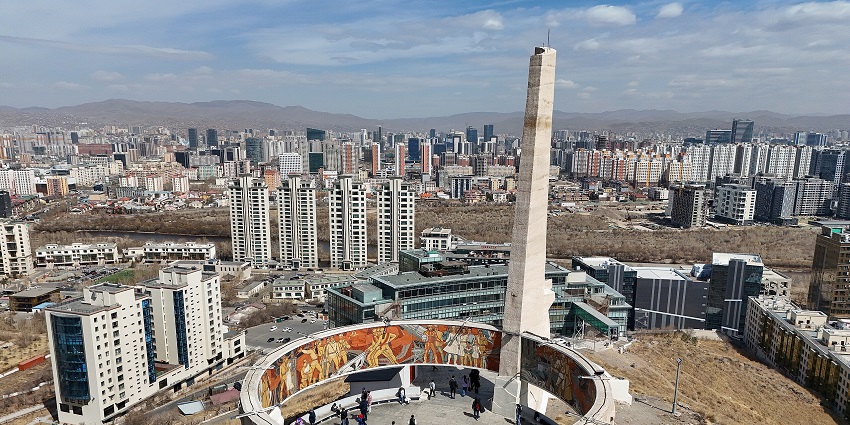
Photo: Quintin Soloviev / Wikimedia Commons
On a hill at the edge of Ulaanbaatar stands the Zaisan Memorial, built to honour Soviet soldiers who died during World War II. Reaching the top requires a steady climb up several hundred steps, but the reward is a panoramic view over the entire city, framed by the distant mountains and the slow curve of the Tuul River. At the centre of the memorial is a large circular mural depicting scenes of friendship between Mongolia and the Soviet Union. The memorial remains a striking landmark and a piece of Cold War history. It is one of the more unusual historical places in Mongolia, blending military tribute with urban scenery.
How To Reach: Located on a hill in southern Ulaanbaatar; 15-minute taxi ride from downtown
Timings: Open all day
Nearby Attractions: Buddha Garden, Manzushir Monastery Ruins, Bogd Khan Uul trails
5. Manzushir Monastery Ruins
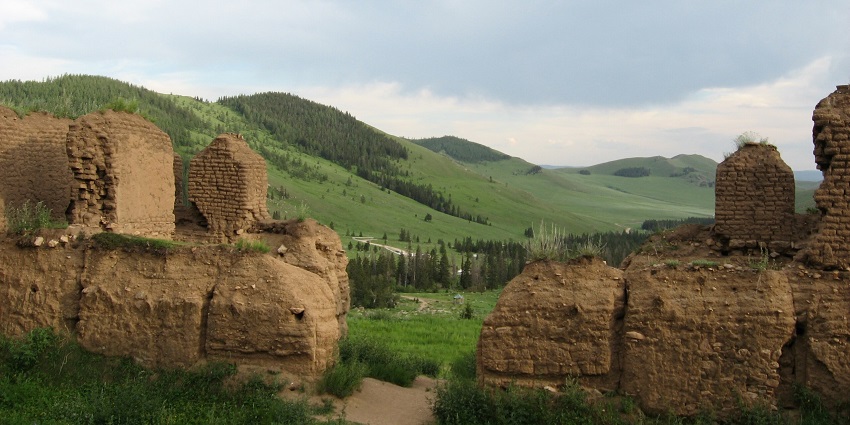
Photo: Yaan / Wikimedia Commons
Hidden in the southern forested edge of Bogd Khan Mountain, Manzushir Monastery was once a thriving religious centre. Founded in 1733, it grew to include over twenty temples and housed more than 300 monks. It remained active for nearly two centuries before it was destroyed during the 1930s political purges. The site now holds one restored temple, scattered ruins, and stone outlines where the monastery once stood. The area is surrounded by Granite cliffs, carved images on rocks can still be seen along the trails, and a small museum near the entrance displays relics and photographs taken before the destruction. Pine trees and high mountain air give the site a quiet atmosphere, making it a thoughtful stop among historical places in Mongolia. Short paths wind through the remains, and the setting is often used by locals for day trips and picnics.
How To Reach: Around 45 km south of Ulaanbaatar; reachable by car or taxi through Zuunmod town
Timings: 9 AM – 6 PM
Nearby Attractions: Bogd Khan Uul National Park, Zaisan Memorial, Aryabal Temple
6. Shankh Monastery
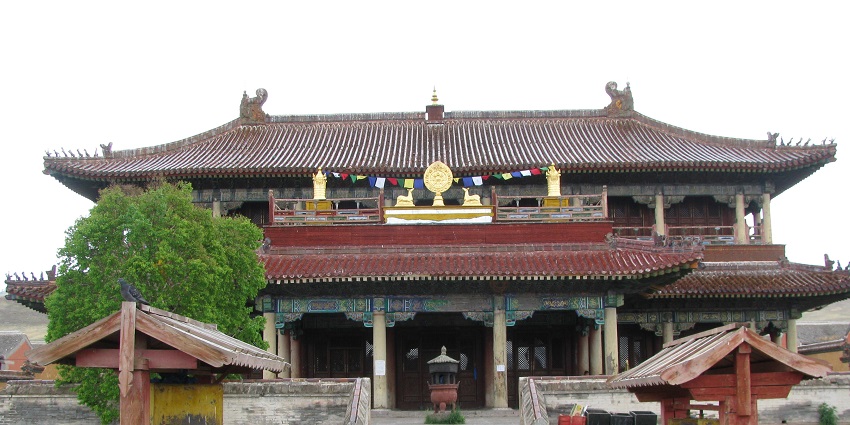
Photo: Mongolia Expeditions / Wikimedia Commons / Image For Representation Only
In the rolling hills near Khujirt and Shankh Monastery is one of the oldest surviving monasteries in the country. Founded in the 1640s, it once served as a major centre of Buddhist learning and was closely associated with Zanabazar, Mongolia’s first spiritual head. The site was partially destroyed during the 1930s, like many religious institutions across the country, but was carefully restored in the early 1990s. Its wooden prayer halls, painted in traditional colours, sit quietly among the grasslands. Inside, you will find sacred texts, statues, and artwork that speak to the monastery’s long role in teaching and worship. You can explore the grounds and observe the daily rituals. As one of the more remote historical places in Mongolia, Shankh offers an experience of calm, space, and a strong sense of continuity.
How To Reach: Located 25 km southwest of Kharkhorin, best accessed by private car or van
Timings: 10 AM – 5 PM
Nearby Attractions: Orkhon River, Tövkhön Monastery, Erdene Zuu
7. Tovkhon Monastery
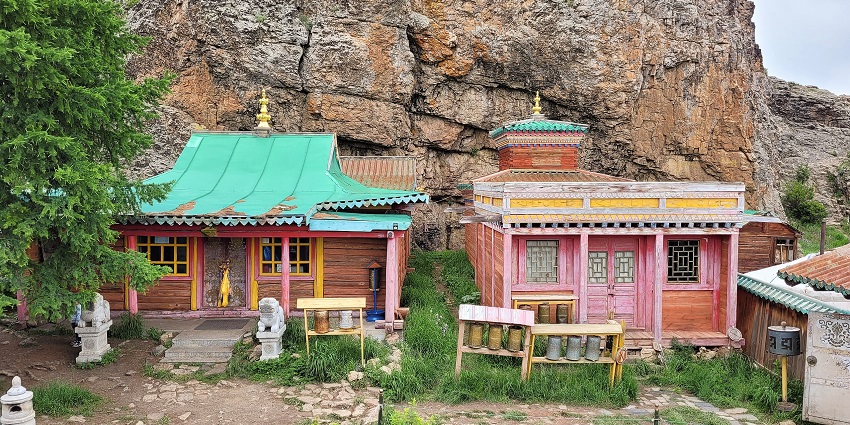
Photo: Bernard Gagnon / Wikimedia Commons
Tövkhön Monastery is set deep in the Khangai Mountains, sitting at nearly 2,300 metres above sea level. Built in 1653 by Zanabazar, the first Bogd Gegeen of Mongolia, the monastery served as his personal retreat. He spent time here creating religious texts, sculptures, and artworks. The buildings are small and wooden, perched on a forested slope with wide views over the Orkhon Valley. Reaching the site involves driving over rough terrain and hiking the final 3 kilometres on foot. The monastery was damaged in the 20th century and later restored, with care taken to preserve its original form. What makes this one of the most distinct historical places in Mongolia is its complete detachment from noise and modern movement.
How To Reach: Reachable from Kharkhorin by 4WD vehicle, followed by a 3 km uphill walk
Timings: 9 AM – 6 PM
Nearby Attractions: Shankh Monastery, Orkhon Valley, Uurtiin Tokhoi viewpoint
8. Sainshand And Khamar Monastery
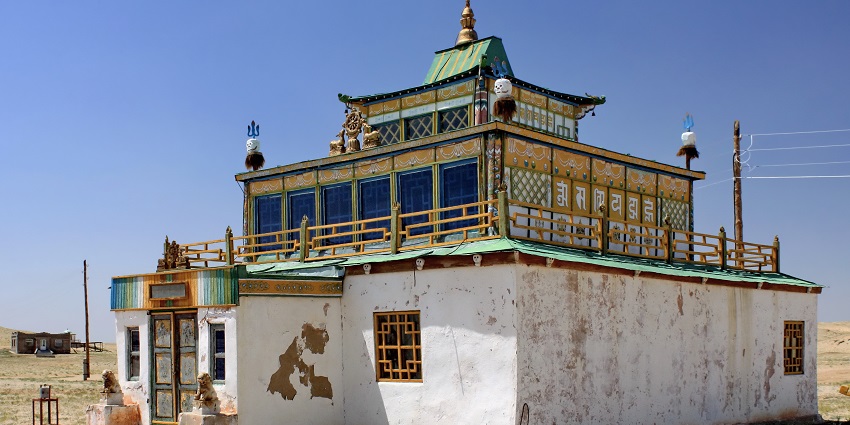
Photo: Marcin Konsek / Wikimedia Commons / Image For Representation Only
In the far southeastern desert, near the town of Sainshand, Khamar Monastery offers a completely different view of Mongolia’s spiritual history. Founded in the 1820s by Danzanravjaa, a revered poet and lama, the site was created as a centre for both religious study and the arts. It included a theatre, school, and library alongside the temples. Though destroyed during the political purges, the monastery has been rebuilt and now serves as a symbol of resilience. The setting is vast and open, with dry desert winds and flat horizons. It is among the most remote historical places in Mongolia, drawing visitors interested in both history and spiritual energy. Nearby is the Energy Centre, where you can come to meditate and reflect. A small museum in Sainshand displays the lama’s original manuscripts, costumes, and personal items.
How To Reach: 10-hour drive or overnight train from Ulaanbaatar to Sainshand; local taxi to monastery
Timings: 8 AM – 6 PM
Nearby Attractions: Energy Centre, Danzanravjaa Museum, Dornogovi landscapes
9. Delgeriin Choir Monastery Ruins
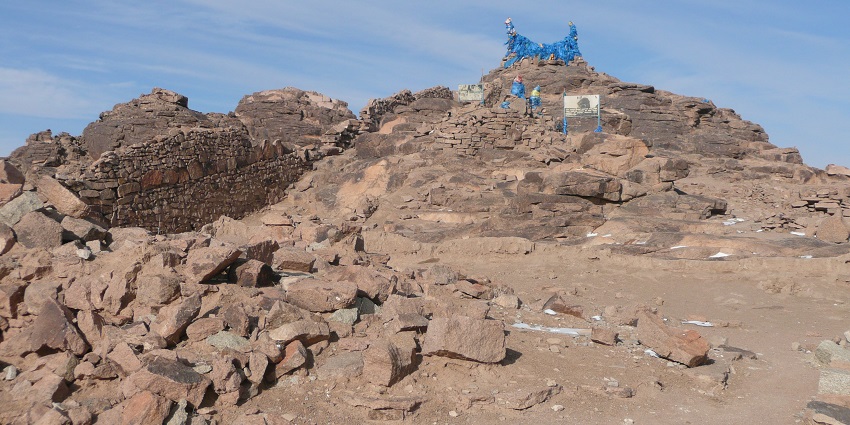
Photo: Brücke-Osteuropa / Wikimedia Commons / Image For Representation Only
In the remote steppe of Dundgovi Province, the ruins of Delgeriin Choir Monastery tell a story of quiet endurance. Built in the 1700s, it was once a major centre for Buddhist teaching and housed hundreds of monks. Like many religious institutions in Mongolia, it was destroyed during the communist purges of the 1930s. Today, only fragments remain with stone foundations, broken walls, and weathered outlines of what was once a large complex. The site is untouched and unguarded, with no fences or signs, making it feel like a hidden chapter of Mongolia’s past. Among all the historical places in Mongolia, this one stands out for its silence and lack of modern interference.
How To Reach: Located in Dundgovi Province; reached by car from Mandalgovi
Timings: 24*7
Nearby Attractions: Ikh Gazriin Chuluu rock formations, Gobi Desert edge
10. Amarbayasgalant Monastery
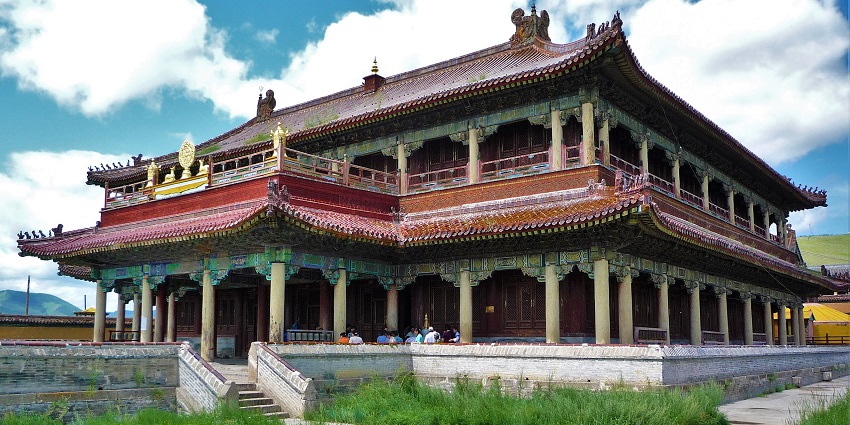
Photo: Bogomolov.PL / Wikimedia Commons
Amarbayasgalant Monastery lies in a wide green valley in Selenge Province, with forested hills rising gently behind it. Built in the 18th century to honour Zanabazar, the first Bogd Gegeen of Mongolia, the monastery is one of the best-preserved architectural sites from that period. Its design follows the Tibetan style, with a long central axis and symmetrical layout. After the destruction much of Amarbayasgalant survived, and careful restoration has helped protect its wooden halls, detailed carvings, and painted interiors. It continues to function as a working monastery, home to a small community of monks. As one of the grandest historical places in Mongolia, it draws travellers who want to see both history and daily spiritual life.
How To Reach: 360 km north of Ulaanbaatar; travel via Bulgan by car or organised tour
Timings: 9 AM – 6 PM
Nearby Attractions: Selenge River, Erdenet city, Bulgan mountain valleys
In Mongolia, history is not separated from daily life. It exists in open fields, mountain ridges, and quiet monasteries. The historical places in Mongolia are not distant or untouched; they are part of the land people still walk, pray, and live on. Some carry the memory of empires; others hold the presence of devotion that continues today. Each place tells its story through stone, wood, silence, and sky. What remains is not just ruins or rituals but a way of remembering that stays close to the surface. So plan your visit with TripXL and explore the ruins and experience the rituals of Mongolia.
Cover Photo: Brücke-Osteuropa / Wikimedia Commons


 WhatsApp
WhatsApp
 Twitter
Twitter









